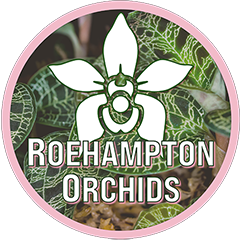How to care for you Phalaenopsis subsection Phalaenopsis
Phalaenopsis orchids, also known as moth orchids, are one of the most popular orchid varieties due to their beautiful flowers and ease of care. With the right conditions and attention to detail, you can enjoy these stunning plants for years to come.
Important: Before reading this guide, ensure your orchid is a Phalaenopsis subsection Phalaenopsis and NOT Phalaenopsis subsection polychilos orchid as they have different cultural requirements.
🌡 Temperature
Phalaenopsis prefer temperatures between 16°C to 27°C. It is important to maintain a temperature difference of 4-6°C between day and night. This temperature fluctuation mimics their natural habitat and promotes healthy growth.
During the pre-spring season, orchids benefit from a temperature dip to 16-18°C during the night. This temperature drop, along with the extended light period signals the plant to enter the spike (flowering) phase.
💡 Light
Phalaenopsis orchids thrive in bright, indirect light. .East Morning or Sunset Light can be direct, Mid-summer day between ~11-4PM indirect. Winter time as much light availability as possible in Canada. Artificial supplementary light recommended in winter and/or low light homes.
💧 Watering
DO NOT use ice cubes. Phalaenopsis orchids should only be watered when the media and roots are fully dry. Avoid following a strict watering schedule, as it may lead to overwatering and root rot. Instead, check the moisture level of the media and roots before watering.
Checking for dryness: Use a transparent inner pot to easily check the dryness of the media and roots. This will allow you to accurately determine when your orchid needs watering.
Soaking method: When it's time to water your Phalaenopsis orchid, soak the entire pot in water for 15-30 minutes. This will ensure 100% saturation and optimal hydration for the roots. After soaking, allow the excess water to drain completely before placing the orchid back in its decorative pot.
Remember, overwatering is one of the most common causes of orchid decline. By following these watering guidelines, you can help prevent root rot and promote healthy growth in your Phalaenopsis orchids.
When roots are abundance, new roots can stay slightly moist. Reverse Osmosis / Distilled or Rain water is preferred but not necessary.
☁️ Humidity
These orchids thrive in higher humidity environments but tolerable to 30% humidity if watered correctly. To increase humidity, you can place a tray of water near the orchid and/or use a humidifier. Avoid dry heat air vents blowing at the plant, especially at the flowers, which may shorten the lifespan of the flower.
🌰 Potting Media
Phalaenopsis orchids prefer a well-draining potting medium to ensure healthy root growth and prevent root rot. Regular potting soil is not suitable for these epiphytic plants.
The combination of bark mix or sphagnum moss LECA combo provides excellent drainage, allowing excess water to flow freely and preventing the roots from sitting in water. This promotes a healthy wet to dry cycle of 5-14 days, which is ideal for Phalaenopsis orchids.
Well-Ventilated Pot
In addition to a well-draining potting medium, it is essential to choose a well-ventilated pot for your Phalaenopsis orchids. A well-ventilated pot allows for better air circulation around the roots, preventing the buildup of excess moisture and reducing the risk of root rot.
If you notice that the potting medium remains wet for more than 14 days, it is a sign that the pot is not providing enough ventilation. In such cases, it is recommended to change to a better-ventilated pot. Look for pots with slotted or multi-layer air ventilation holes to ensure optimal airflow.
You can also increase airflow in your grow space by using fans. This will help to prevent stagnant air and promote better ventilation and evaporation around the plants.
If you are experiencing persistent issues with moisture retention, consider repotting your Phalaenopsis orchids with a looser media choice. This can help improve drainage and prevent waterlogging.
🧪 Fertilizing
Feed your Phalaenopsis orchid when it's actively growing in vegetative stage - typically when a top leaf emerges and growing. We recommend MSU & Marphyll rotation in low dosage every other watering and allow water flushing in between.
Dosage can be weekly weakly during the growing season and down to once a month over winter dormancy.
Finally, take the time to appreciate the beauty of your Phalaenopsis orchid. These plants can bloom for several months, and with proper care, they can rebloom every year after year.
By following these care tips, you can ensure that your Phalaenopsis orchid thrives and brings joy to your home or office. Remember, each orchid is unique, so observe your plant closely and make adjustments to the care routine as needed. Happy orchid growing!
Orchids reimagined.
Close your eyes and picture an orchid. What you see is a tall slender stem with a cascade of blooms. We're here to broaden that definition.
Roehampton Orchids is a tropical nursery located in the heart of Toronto. We've opened our doors intent on rejuvenating the outdated image of the orchid, and hope to share a new vision of these remarkable plants with our customers. We source rare and unique varieties from countries around the world, cultivated by our team here in the city. Our extensive collection of orchids, from Goodyera (Jewels) to various Vandeae including Phalaenopsis, is yours to learn and discover.
We've developed innovative growing techniques, which allow us to bring healthy tropical plants to the Canadian market. Each plant is grown with the highest degree of attention and care. To ensure these beautiful orchids will continue to flourish in your home, we promise to help every step of the way - this is our commitment to you
- Roehampton Orchids -
